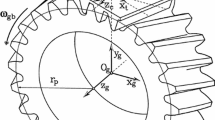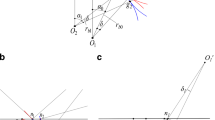Abstract
A new model of the gear hobbing process is presented in this paper to determine the micro tooth surface topography in spur and helical gears. The model is based on the generation of tooth surfaces by successive cuts of the finite number of hob teeth, as they come into interaction with the gear tooth. For every relative position of the hob and the gear, an analysis is carried out to find the active cutting edge points which generate the gear tooth surface. Repeating this procedure for all the selected gear tooth surface points, the micro topography of the gear tooth surface is determined. Therefore, the developed method determines the deviations of the manufactured tooth surface from the theoretical tooth surface of spur and helical gears. The method is applied to improve the micro tooth surface topography of spur and helical gears, namely to reduce the deviations of the hobbed tooth surface. Spur and helical gear examples are used to demonstrate the effectiveness of the method.















Similar content being viewed by others
Abbreviations
- \(h\) :
-
Deviation of the hobbed tooth surface
- \(i_{\text{v}}\) :
-
Ratio of the angular velocities of the hob and the gear
- \(m_{\text{n}}\) :
-
Normal module (mm)
- \(N_{\text{cut}}\) :
-
Number of hob cutting edges
- \(N_{\text{g}}\) :
-
Gear tooth number
- \(N_{\text{h}}\) :
-
Hob tooth number
- \(N_{\text{htread}}\) :
-
Hob thread number
- \(R_{z}\) :
-
Roughness height (μm)
- \(R_{ \hbox{max} }\) :
-
Maximum roughness height (μm)
- \(r_{\text{f}}^{{\left( {{\text{c}} . {\text{e}} .} \right)}}\) :
-
Cutting edge variable (mm)
- \(r_{\text{o}}\), \(r_{\text{og}}\), \(r_{\text{oh}}\) :
-
Pitch cylinder radii of the involute helical surface, gear, and hob, respectively (mm)
- \(r_{\text{b}}\), \(r_{\text{bg}}\), \(r_{\text{bh}}\) :
-
Base cylinder radii of the involute helical surface, gear, and hob, respectively (mm)
- \(s_{0}\) :
-
Axial feed of the gear per gear revolution (mm/rev)
- u, \(u_{\text{g}}\), \(u_{\text{h}}\) :
-
Surface variables (mm)
- \(\alpha_{ 0}\) :
-
Pressure angle on the pitch cylinder (°)
- \(\alpha\) :
-
Pressure angle in an arbitrary chosen tooth surface point (°)
- \(\alpha_{\text{n}}\) :
-
Normal pressure angle (°)
- \(\alpha_{\text{t}}\) :
-
Transverse pressure angle (°)
- \(\beta_{ 0}\) :
-
Helix angle of the helical gear on the pitch cylinder (°)
- \(\beta_{\text{b}}\) :
-
Helix angle of the helical gear on the base cylinder (°)
- \(\omega_{0}\), \(\omega_{{0{\text{h}}}}\) :
-
Lead angles on the pitch cylinder (°)
- \(\omega_{\text{b}}\), \(\omega_{\text{bh}}\) :
-
Lead angles on the base cylinder (°)
- \(\omega^{{\left( {\text{g}} \right)}}\), \(\omega^{{\left( {\text{h}} \right)}}\) :
-
Angular velocities of the gear and the hob, respectively (sec−1)
- \(\theta\), \(\theta_{\text{h}}\) :
-
Surface variables (°)
- \(\theta_{i}^{{\left( {{\text{c}} . {\text{e}} .} \right)}}\) :
-
Parameter of the cutting edge (°)
References
Hannam RG, Andrew C (1968) An analysis of the geometry of gear hobbing. Prod Inst Mech Eng 182:559–570
Cooke DAD, Welbourn DB (1967) Forces in gear hobbing-1, spur gears. Mach Prod Eng 9:475–477
Cooke DAD, Welbourn DB (1968) Forces in gear hobbing-1, helical gears. Mach Prod Eng 2:258–261
Terashima K, Ueno T (1978) Numerical analysis of hobbing in unfinished space. Bull JSME 21(155):907–914
Terashima K, Ueno T (1980) Graphical analysis of hobbing in unfinished space. Bull JSME 22(180):983–990
Bouzakis K, Kombogiannis S, Antoiniadis A, Vidakis N (1999) Modeling of gear hobbing part 1—cutting simulation and tool wear prediction models. In: Symposium on material behavior in machining, Nashville, pp 253–259
Weck M, Hurasky-Schönwerth O, Winter W (2002) Manufacturing simulation for the analysis of the gear hobbing process. In: International conference on gears VDI-Berichte, 1 Nr. 1665
Abood AM, Bicker R, Pennell T (2004) Cutting forces in gear hobbing. In: Proceedings of the 11th world congress in mechanism and machine science, Tianjin, pp 896–900
Nectarios VD, Antoniadis A (2007) Advanced computer aided design simulation of gear hobbing by means of three-dimensional kinematics modeling. ASME J Manuf Sci Eng 129:911–918
Radzevich SP (2007) A way to improve accuracy of hobbed involute gears. ASME J Mech Des 129:1076–1085
Pohit G (2006) Application of virtual manufacturing in generation of gears. Int J Adv Manuf Technol 31(1):85–91
Michalski J, Skoczylas L (2007) Modelling the tooth flanks of hobbed gears in the CAD environment. Int J Adv Manuf Technol 36(7):746–751
Michalski J (2009) Surface topography of the cylindrical gear tooth flanks after machining. Int J Adv Manuf Technol 43:513–528
Dimitriou V, Antoniadis A (2009) CAD-based simulation of the hobbing process for the manufacturing of spur and helical gears. Int J Adv Manuf Technol 41(3):347–357
Berbinschi S, Teodor V, Oancea N (2013) 3D graphical method for profiling gear hob tools. Int J Adv Manuf Technol 64(1):291–304
Khalilpourazary S, Meshkat SS (2014) Investigation of the effects of alumina nanoparticles on spur gear surface roughness and hob tool wear in hobbing process. Int J Adv Manuf Technol 71(9):1599–1610
Gravel G (2014) Simulation of deviations in hobbing and grinding. In: Gear technology, September/October, pp 56–60
Cao WD, Yan CP, Ding L, Ma YF (2016) A continuous optimization decision making of process parameters in high-speed gear hobbing using IBPNN/DE algorithm. Int J Adv Manuf Technol 85(9):2657–2667
Dong X, Liao C, Shin YC, Zhang HH (2016) Machinability improvement of gear hobbing via process simulation and tool wear predictions. Int J Adv Manuf Technol 86(9):2771–2779
Wang YZ, Chen YY, Zhou GM, Lv Q, Zhang ZZ, Tang W, Liu Y (2016) Roughness model for tooth surfaces of spiral bevel gears under grinding. Mech Mach Theory 104:17–30
Chen H, Tang J, Zhou W, Chen C (2017) The equal theoretical surface roughness grinding method for gear generating grinding. Int J Adv Manuf Technol 90:3137–3146
Simon V (2016) Micro tooth surface topography of face-milled hypoid gears. Mech Mach Theory 104:370–381
Evans HP, Snidle RW, Sharif KJ (2009) Deterministic mixed lubrication modelling using roughness measurements in gear applications. Tribol Int 42:1406–1417
Kolivand M, Kahraman A (2010) Prediction of mechanical gear mesh efficiency of hypoid gear pairs. Mech Mach Theory 45(11):1568–1582
Li S, Kahraman A (2010) A transient mixed elastohydrodynamic lubrication model for spur gear pairs. ASME J Tribol 132(1):011501
Liu H, Mao K, Zhu C, Xu X (2012) Mixed lubricated line contact analysis for spur gears using a deterministic model. ASME J Tribol 134:021501-1–021501-7
Mohammadpour M, Theodossiades S, Rahnejat H, Saunders T (2014) Non-Newtonian mixed elastohydrodynamics of differential hypoid gears at high loads. Meccanica 49:1115–1138
Li S (2015) A thermal tribo-dynamic mechanical power loss model for spur gear pairs. Tribol Int 88:170–178
Mohammadpour M, Theodossiades S, Rahnejat H, Dowson D (2017) Non-Newtonian mixed thermo-elastohydrodynamics of hypoid gear pairs. Proc Inst Mech Eng Part J J Eng Tribol. https://doi.org/10.1177/1350650117700756
Simon V (1982) Grinding wheel profile for hob relief grinding. ASME J Mech Des 104:734–742
Simon V (1988) Computer aided manufacturing of high precision hobs. Int J Mach Tools Manuf 28:443–452
Author information
Authors and Affiliations
Corresponding author
Additional information
Technical Editor: Márcio Bacci da Silva.
Rights and permissions
About this article
Cite this article
Simon, V.V. Improvements in the micro tooth surface topography of hobbed spur and helical gears. J Braz. Soc. Mech. Sci. Eng. 40, 210 (2018). https://doi.org/10.1007/s40430-018-1148-y
Received:
Accepted:
Published:
DOI: https://doi.org/10.1007/s40430-018-1148-y




